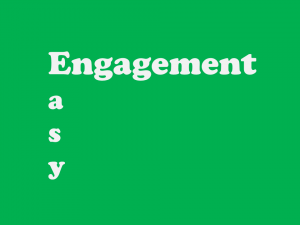If you have been involved with marketing in any capacity in the last 3-5 years, you have likely heard the term “customer engagement” uttered many times. It has become the holy grail of marketing, in some respects more elusive than making sales. After all, transaction marketing can occur in the absence of buyers forming a significant bond or relationship with the seller. However, establishing relationships with customers cannot be achieved without meaningful engagement taking place.
The term engagement is thrown around a lot in marketing circles, so I ask students early on to tell me what they think engagement means. Examples of answers I have heard include “extensive interaction,” “two-way communication,” “committed relationship,” and “ongoing interaction.” Like the concept of engagement applied to personal relationships, customer engagement reflects a situation in which two parties feel they benefit from their interaction/communication/relationship with each other.
Two Types of Engagement
Engagement is not only a hot topic in terms of the quest to achieve it; marketers are also challenged to figure out how to make engagement happen as well as how to measure it. A recent blog post by Tracey Parsons of SME: Digital about social media engagement made an interesting observation: Engagement is not a single-dimension construct. Rather than thinking about engagement, we should consider what type of engagement we want and are achieving. Parsons identifies two types of engagement: 1) passive and 2) active. Passive engagement refers to behaviors such as Likes on Facebook or following on Twitter. It is a metric many brands used to evaluate the impact of their social media efforts. Active engagement reflects a deeper interaction between audience and brand- sharing and commenting being two ways in which active engagement occurs.
Engagement is not Easy
The call to break out engagement into differing levels of interaction is spot on. And, marketers must be careful not to limit their concept of engagement to passive metrics. Passive engagement could also be called easy engagement. Why? It is relatively easy to achieve. But, are we after easy or after creating impact? Here are three concerns related to a focus on easy engagement:
- Easy Engagement ≠ Meaningful Engagement – Passive engagement metrics such as audience reach (followers/likes) and likes are of interest to many businesses because they are easy to understand, interpret, and even get. Think about it- How much effort is required for someone to like a business or brand on Facebook? One click will do it.
- Easy Engagement ≠ Earned Engagement – Some of the audience reach you build comes with minimal buy in from your community. Heck, you can get “engagement” if we inadvertently click a Like button while going through our feed. That is not engagement; that is an accident! Similarly, engagement can be bought for the price of redeeming a coupon or other offered given in exchange for engaging via a like or follow.
- Easy Engagement ≠ Ongoing Engagement – When customer engagement efforts are reduced to transactions (you like me and I will give you something) or outright begging (please like us on Facebook- only 10 away from 1,000), they are short-term tactics that will not achieve long-term goals. Pursuing engagement via easy engagement is like the insecure guy who buys a round of drinks for patrons at a bar. He wins over friends, at least until they get to the bottom of the glass. Then what? The “friendship” is likely over.
Engagement will continue to be a topic for which marketers will have differing views of what it means, how to achieve it, and how to measure it. I am not dismissing the need to achieve easy engagement- you have to start somewhere in relationship building. But, just as becoming aware of a brand after viewing a TV commercial usually does not translate into making sales, achieving passive or easy engagement with your audience will not lead them to remain engaged with you.


